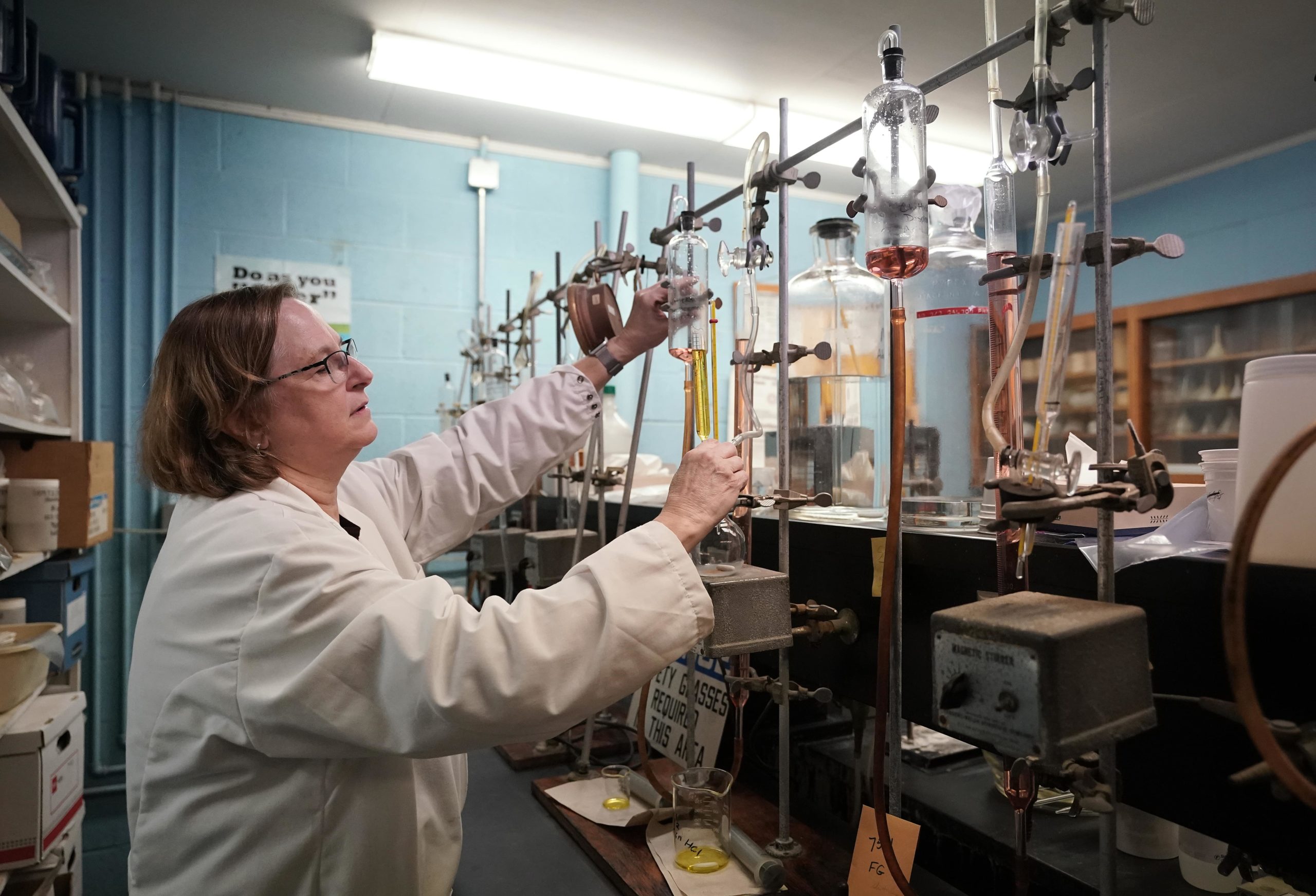
Associate & Affiliate Members
The IHA invites researchers to support its mission as associate and affiliate members. Associate members have a three-year appointment and received funding to cover costs of hiring a post-doctoral research associate and other related research expenses. Affiliate members have a one-year appointment, with some being granted seed funding based on their research and its mutually beneficial qualities. Collaboration with one or more of our three focus areas was strongly encouraged for both types of memberships.
Associate Member Spotlight

Jeffery Tomberlin
Professor, Department of Entomology
Post Doctoral Position
Under Jean Mayer, USDA Human Nutrition Research Center on Aging, Tufts University
Project title: Edible insects and health. The commercial industry around entomophagy was valued at 33 million USD in 2015, with future growth estimated at more than 40% by 2023. The release of the Food and Agriculture Organization of the United Nation’s publication “Edible Insects: Future Prospects for Food and Feed Security” in 2013 accelerated attention to the past, present, and future uses of insects as components of human diets and as animal feed ingredients. Studies on the role of insects in food systems cross disciplinary boundaries and bring together scientists from natural and social science as well as the humanities to document the past and explore the future potential of this group of organisms that up until now have escaped the globalization of food systems. This research will address the knowledge gaps related to the incorporation of edible insects as part of Precision Nutrition.
Associate Members

William L. Rooney
Soil & Crop Science
Dr. Rooney’s Research
Project title: Enhancing the health benefits of specialty grain sorghum hybrids for the U.S. food industry. This project will build on previously established gains in knowledge from AgriLife Research on sorghum breeding and nutrition to produce hybrid sorghum genotypes that are more productive, and economically favorable to grain producers and processors while focusing on genetic traits of sorghum that are beneficial to human health, such as increased antioxidant content and starches lower in digestibility which reduces glycemic index.

Dmitry Kurouski
Biochemistry & Biophysics
Dr. Kurouski’s Research
Project title: Raman-based sensing of human and plant health. This project focuses on a non-invasive and non-destructive technique which has previously been used to sense the health of plants. The researchers propose expanding the application of this modern analytic technique to 1) detect and identify metabolism diseases and aging processes in humans; 2) assess the nutritional composition of seeds and fruits and changes in nutritional value based on fruit ripeness; 3) deploy these techniques to differentiate genotypes and phenotypes in plant breeding and selection.

Katie Lynn Lewis
Lubbock AgriLife Research & Extension Center
Dr. Lewis’s Research
Project title: Enhancing health on the Texas High Plains with sustainable and resilient cropping systems that mitigate wind erosion and dust control. This project will answer critical questions about how wind erosion detrimentally impacts human health, and identify strategies to help sustainably improve crop production in the semi-arid Texas High Plains.

Bruce McCarl
Agricultural Economics
Dr. McCarl’s Research
Project title: Agriculture sector analysis of environmental developments and nutritional initiatives. The initial work of this project aims at applying cost-benefit analysis to the agriculture sector, specifically in looking at climate change on livestock production and location, and the effects of increasing market share for grass-fed beef with the goal of informing future agricultural practices to continue to produce an abundant supply of nutritious food within constraints of climate change, and technological and policy initiatives.

Yuxiang sun
Nutrition
Dr. Sun’s Research
Project title: Ghrelin – a unique biomarker for nutritional state and inflamm-aging. This project aims to determine whether current knowledge of ghrelin in animal models is applicable to humans, and to determine whether ghrelin is a good biomarker of aging. Ghrelin is a hormone correlated with increasing food intake and promoting obesity, inflammation and metabolic dysfunctions in humans, however, application of knowledge gained over the past few decades is limited. Currently the regulation of aging immunity – or “inflamm-aging” – is not well understood, however, researchers propose that ghrelin could be a reliable biomarker for the prediction of metabolic and inflammation states in aging and inform healthy aging interventions.

Bhimu Patil
Vegetable & Fruit Improvement Center
Dr. Patil’s Research
Project title: Green N-Carbon Dots to Develop Climate Resilient Tomatoes with Enhanced Health Promoting Bioactive Compounds. This project aims to develop green, non-toxic nitrogen-doped carbon dot system for use with tomato farming in order to enhance drought tolerance as well as nutritive value. Seed nano-priming can improve sustainability by promoting establishment of plants, protecting against biotic and abiotic stresses, improving productivity and enhancing levels of health promoting bioactives.

Marco a. palma
Department of Agricultural Economics, Human Behavior Laboratory
Dr. Palma’s Research
Project title: Implementing Nutritional Interventions to Enhance Compliance and Adoption of Healthier Lifestyles. This project will design and implement nutritional interventions in lab and field settings to increase the consumption of fruits and vegetables and promote the adoption of lasting lifestyle changes with an emphasis on obesity and diabetes management. As part of this proposed project, researchers will work to evaluate the effects of exogenous provision of food products in food assistance program frameworks to create demand and habit for consumption of healthy food. Many barriers exist when it comes to healthy food habits, including familiarity, food preparation or other social influences. Neurophysiological equipment in lab will be used to enrich the choice process data in order to better understand emotional/social drivers of food preferences.

Alexandra L. MacMillan uribe
Dallas Research & Extension Center, Nutrition, IHA Healthy Living Team
Dr. MacMillan Uribe’s Research
Project title: Produce Rx: Increasing Fruit and Vegetable Intake and Improving Cardiometabolic Health Indicators Among Urban, Low-Income Adults and Caregiver-Toddler Dyads. This project will test an incentive model in which healthcare providers “prescribe” fruit and vegetable boxes paired with cooking and nutrition education among low-income and disadvantaged adults with cardiovascular disease and toddlers – two groups disproportionately burdened by diet-related chronic conditions and lacking access to healthy foods. We will evaluate the contributions of educational and skill-building programming to the impact of fruit and vegetable prescription program on cardiometabolic outcomes and conduct a the cost effectiveness of Produce Rx, two novel contributions to the scientific literature. Currently, our partner clinics are referring participants to Produce Rx.

jacob s. szeszulski
Dallas Research & Extension Center, Nutrition, IHA Healthy Living Team
Dr. Szeszulski’s Research
Project title: Optimizing the Effectiveness and Impact of the Healthy School Recognized Campus and Strong Teens for Healthy Schools Change Club Programs partners with Extension educators to empower middle school teachers, administrators, and students to create transformative change in their school’s food systems and/or nutrition environments, improve food equity, and increase the school’s capacity to deliver evidence-informed programming. This study uses a sophisticated scientific research process, the Multiphase Optimization Strategy (MOST), to test combinations of interventions and support strategies and identify the most efficient and effective approaches for reducing cardiovascular disease risk factors – a process that will ensure a scalable solution that can be disseminated to promote healthy trajectories for youth across Texas.

chad rethorst
Dallas Research & Extension Center, Nutrition, IHA Healthy Living Team
Dr. Rethorst’s Research
Project title: Strong Hearts, Healthy Communities (SHHC) Digital Intervention. This project will develop a digital version of the evidence-based health behavior change intervention – Strong Hearts, Healthy Communities – leveraging cutting-edge technologies and intervention delivery approaches to optimize intervention effectiveness. The resulting digital intervention will not only target individual behavior change but will also incorporate novel engagement strategies that foster social support and community engagement to address the social and environmental factors that influence health.
Project title: Strong Hearts, Healthy Communities (SHHC) Urban Adaptation. This project addresses disparities in health experienced by Black and Hispanic residents in Dallas through the tailoring an evidence-based program – Strong Hearts, Healthy Communities (SHHC). SHHC uses a multisectoral approach to target individual, social, environmental, regional, and cultural challenges that uniquely impact the cardiovascular disease risk of Black and Hispanic urban Texans. Effective adaptation of the SHHC program will result in an evidence-based program uniquely designed to improve the health of Black and Hispanics urban Texans, and our adaptation process will be replicable so that we can continue to adapt health promotion programs that address the needs of underrepresented and disadvantaged populations across Texas.
Post Doctoral Position Under Dr. Janet Antwi, Prairie View University
Diabetes and nutrition. Diabetes, and other chronic diseases, cause significant disease burden, which can be reduced through health behavior change. Many healthy living-focused interventions target individual-level behavior change; yet complex social and environmental factors, such as food insecurity and the built environment, contribute to poor health outcomes associated with diabetes and other chronic diseases, suggesting the need for multilevel interventions. The goal of this research is to develop and evaluate community-engaged interventions that target the social and environmental contexts that affect healthy living behaviors in underserved communities.

Jeffery Tomberlin
Post Doctoral Position
Under Jean Mayer, USDA Human Nutrition Research Center on Aging, Tufts University
Dr. Tomberlin’s Research
Project title: Edible insects and health. The commercial industry around entomophagy was valued at 33 million USD in 2015, with future growth estimated at more than 40% by 2023. The release of the Food and Agriculture Organization of the United Nation’s publication “Edible Insects: Future Prospects for Food and Feed Security” in 2013 accelerated attention to the past, present, and future uses of insects as components of human diets and as animal feed ingredients. Studies on the role of insects in food systems cross disciplinary boundaries and bring together scientists from natural and social science as well as the humanities to document the past and explore the future potential of this group of organisms that up until now have escaped the globalization of food systems. This research will address the knowledge gaps related to the incorporation of edible insects as part of Precision Nutrition.

Joseph Awika
Post Doctoral Position
Under Dr. Danielle Lemay, USDA-ARS Western Human Nutrition Research Center, UC-Davis
Dr. Awika’s Research
Project title: Prediction of microbiota-dependent effects of fine-scale food composition on human health using Big Data and AI/ML approaches. One barrier to precision nutrition is that today’s analysis of diet is summarized at the level of broad food groups or fewer than 100 nutrients. A comprehensive food composition database, FooDB, contains over 15,000 unique biochemicals detected in food. More than 99% of our nutrient exposure is unidentified “dark matter” that is not captured in dietary analyses. Human gut microbiomes harbor thousands of enzymes not available in the human genome and it has been shown that gut microbiota composition influences even post-prandial glucose in healthy adults. Current dietary recommendations do not account for the thousands of chemical compounds in foods or incorporate the functional capacity of the consumer’s gut microbiome. The aim of this research is to predict microbiome-aware health effects of foods with different fine-scale compositions, particularly polyphenol content.

Robert Chapkin
Post Doctoral Position
Under Dr. Laxmi Yeruva, USDA-ARS Labs, Little Rock AR
Dr. Chapkin’s Research
Project title: Human milk Oligosaccharides in gut health. Epidemiologic studies support numerous benefits of breastfeeding compared to formula feeding, particularly related to gut and immune outcomes. Gastrointestinal and immune development are influenced by dietary intake and the gut microbiome. Human milk oligosaccharides (HMOs), a group of complex carbohydrates that represent the third most abundant component of human milk, can both directly and indirectly (via the microbiome) affect intestinal epithelial and immune cells. The goal of this research is to investigate the molecular mechanisms whereby HMOs regulate intestinal epithelial and mucosal immune cells using germ-free and gnotobiotic mice in combination with single cell sequencing.

Matthew Taylor
Post Doctoral Position
Under Dr. Javad Barouei, Prairie View University
Dr. Taylor’s Research
Project title: Microbial Food Safety. The use of raw or improperly composted manure by small farms is a common practice that may result in contamination of produce with foodborne pathogens originated from livestock intestinal reservoirs. Additionally, a contributing factor to the dissemination of pathogen-contaminated food crops is the opportunity for harvest equipment and tools to facilitate pathogen attachment and subsequent cross-contamination of previously non-contaminated fruits, vegetables. The risk for the acquisition of foodborne illness is higher with fresh produce consumed raw or after minimal processing versus items subjected to further processing. This position will focus on identification of microbial communities and survival and persistence of naturally occurring foodborne pathogens in soils amended by manure-based biological soil amendments and on produce grown in such soils using current practices that are typical of small-scale growers of fresh produce.

Elizabeth Racine
Scientific Advisory Committee Member
Post Doctoral Position
Under Drs. Julie Hess & James Roemmich, USDA-ARS Grand Forks Nutrition Research Center
Dr. Racine’s Research
Project title: Precision Nutrition research in adolescent females. The2020-2025 Dietary Guidelines for Americans (DGA) indicates that the population group with the greatest differences between recommended food group amounts and current intakes is adolescent females ages 14-18y. This gap between recommendations and intake is especially concerning because adolescence is such a crucial period of growth and development. In addition, adolescents have more autonomy over food choices than younger children but are still dependent on their parents or guardians for the types of foods available in the home and the preparation of those foods. Adolescent females are, therefore, an ideal population subgroup to benefit from precision nutrition research. Using a precision nutrition approach, this project proposes to develop a more detailed understanding of the current nutritional status of adolescent females and a broader and deeper understanding of the factors affecting the dietary choices of adolescent females and their parents.

REgan Bailey
IHA Co-Director
Post Doctoral Position
Under Dr. Alanna Moshfegh at USDA-ARS Lab
Dr. Bailey’s Research
Project title: Nutrients and food components in national dietary surveillance – WWEIA. What We Eat In America (WWEIA) assesses and reports the dietary intake of the U.S. population. The data are used to inform Federal food and nutrition policy and by researchers to investigate associations between diet and health. Intake of energy and 64 nutrients is reported in WWEIA as they are the traditional nutrients available in USDA’s National Nutrient Database for Standard Reference. Launch of USDA’s FoodData Central in 2019 has changed the source for nutrient values in WWEIA. It is unclear if data for all nutrients reported in WWEIA are necessary for nutrition monitoring and research and what other nutrients might be needed. This project seeks to identify nutrients/food components scientifically and systematically to be reported by national dietary intake assessment to develop an evidence-based rationale/criteria for inclusion or exclusion.

Heidi Vanden Brink
Nutrition
Dr. Vanden Brink’s Research
Building an interdisciplinary research program that intersects nutrition, metabolism, and reproductive physiology and is guided by the overarching aim: to detect, understand, and prevent the integrative mechanisms responsible for aberrant reproductive development during the adolescent reproductive transition. The Vanden Brink Lab studies how polycystic ovary syndrome (PCOS) can manifest during adolescence and the role of diet and living with obesity in their capacity to disrupt reproductive maturation in the later pubertal stages, leading to PCOS. The goals of our lab are to define the role of precision nutrition for optimal adolescent reproductive maturation, establish early biomarkers of reproductive axis miscalibration before conditions such as PCOS manifest, and identify targeted interventions for PCOS prevention.
Affiliate Members
- Stephen Smith
- Mikhailo Kolomiets
- Azlan Zahid
- Delbert Gatlin
- Ximing Wu
- John Cason
- Guoyao Wu
- Luis Cisneros-Zevallos
- Keerti Rathore
- Vishal Gohil
- Amir Ibrahim
- Qingyi Yu
- Qingwu Xue
- Yvette Yu Zhang
- Grace Melo
- Chris Hollenbeck
- Stanley Samonte
- Rosemary Walzem
- Holli Leggette
- Shyamal Talukder
- Wenwei Xu
- Srinivasulu Ale
- Waltram Ravelombola
- Vlad Panin
- Jackie Rudd
- Youjun Deng
- Kim Dooley
- Vijay Joshi
- Giri Athrey
- Luis Tedeschi
- Tryon Wickersham
- Steven E. Riechman
- Yuri Clements Daglia Calil
- Genhua Niu
- Kranthi Mandadi
- Nithya Rajan
- Oral Capps
- Michael Satterfield
- Ke Zhang
- George Perry
- Erin Giles
- Zong Liu
- Genhua Niu
- Kranthi Mandadi
- Nithya Rajan
- Oral Capps
- Michael Satterfield
- Ke Zhang
- George Perry
- Erin Giles
- Zong Liu
- Rodolfo Cardoso
- Pingwei Li
- Salvatore Calabrese
- Gary Voelker
- Michael Polymenis
- Gerald Smith
- Chaodong Wu
- Wesley Osburn
- Ky Pohler
- Paul Feldman
- Aruna Weerasooriya
- Kiran R Gadhave
- Sushil Paudyal
- Xingmao Ma
- Reza Ovissipour
- Joydeep Chakraborty
- Lanying Zeng
- Jenny Wu
- Jean-Philippe Pellois
- Gurjinder Baath
- Fugen Dou
- Jake Mowrer
- Xiuren Zhang
- Devendra Pandeya
- Jaehak Jeong
- Linglin Xie
- Susie Dai
- Russell Jessup
- Fuller Bazer
- Sandun Fernando
- Andy Herring
- Paul DeLaune
- Eunsung Kan
- Jaehyun Cho
- Juliana Rangel
- James Petrick
- Muthukumar Bagavathiannan
- Nuria Gomez-Casanovas
- Shuyu Liu
- Michael Thomson
- Lee Tarpley
- Tazim Jamal
- Senarath Dharmasena
- Jorge DaSilva
- Xuejun Dong
- Endang Septiningsih
- Shuyang Zhen
- Xudong Rao
- Xingguo Wang
How to become an IHA Affiliate Member
Although we are not currently seeking new members to our Associate Members group, we are accepting new Affiliate Members. Please fill in the form below if you are interested in becoming an IHA Affiliate Member.
IHA Membership Inquiry